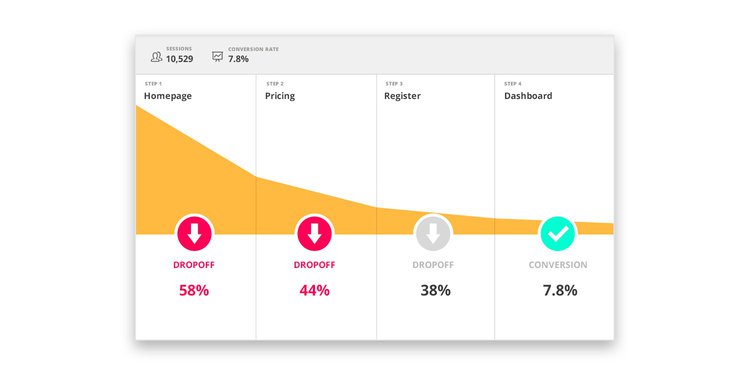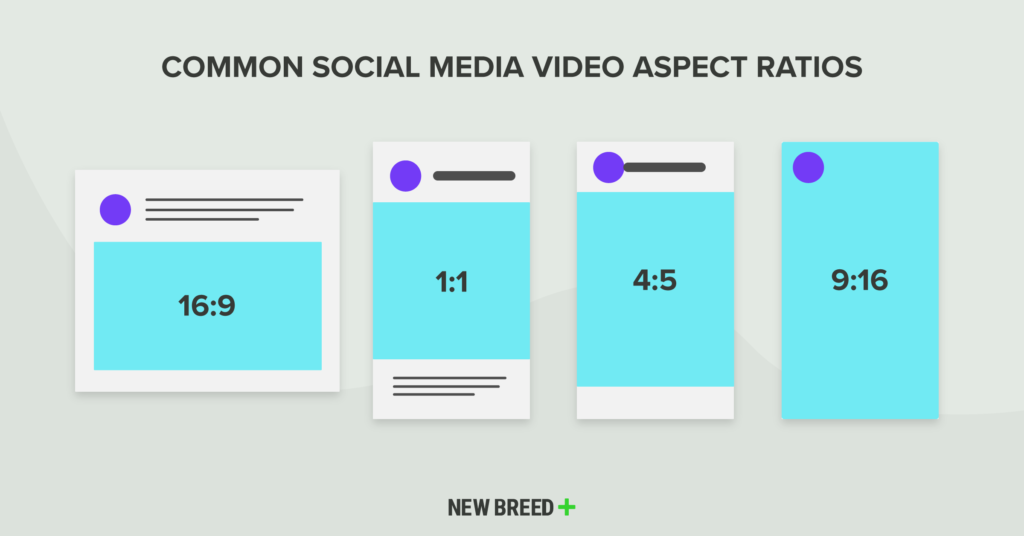Lots of marketers and business owners use a ‘buyer’s journey’ or ‘sales funnel’ to describe their acquisition process.
But too many focus too much on the beginning of the journey, or the top of the funnel, where leads come in and learn about the offer but don’t convert.
The most effective sales funnel improvements, however, start at the bottom. But before we get into that, let’s clarify what ‘bottom-of-funnel optimization’ even means.
Anatomy of a Sales Funnel
Sales funnels are concepts that businesses use to visualize a customer’s journey from stranger to lead to buyer. As users move closer to a conversion, you can refine your targeting from broad ‘top-of-funnel’ outreach to narrow ‘bottom-of-funnel’ persuasion tactics.
HubSpot, for example, offers a simplified buyer’s journey with just three funnel stages — Awareness, Consideration, and Decision. Depending on your offer and the level of customer education required, your funnel could have more steps, but three is probably the minimum.
If you’re tracking conversion actions as indicators of where buyers are in the funnel, you can see where (and how many) prospects are opting out at each stage:

Once you know how your funnel is performing, you can start running tests and making improvements to reduce the drop-off rate at each level.
Who’s at The Bottom of My Funnel?
Unlike leads who are just learning about your offer or at the comparison shopping stage, bottom-of-funnel prospects know who you are, what you do, and why they need your product or service.
For eCommerce brands, this is a would-be buyer who has already clicked through products on your page. For subscription-based or SaaS companies, this is someone who has downloaded a case study or free trial. Similar client avatars appear in just about every organization’s marketing playbook.
3 Reasons to Start Sales Funnel Optimization at the Bottom
Capturing more of these users can transform your business, via both short-term results and long-term success. But first, let’s look at why starting sales funnel optimization at the bottom is so important.
1. It’s Your Customer Segment Closest to Conversion
Prospects at the bottom of your funnel are typically right on the cusp of taking action. They’ve seen your ads, visited your website, and maybe even put items in a cart.
If you can reduce friction at this stage by proactively answering potential objections, offering social proof, and/or streamlining the conversion process, you’ll capture a larger portion of this segment — and leave less money on the table.
2. Most Impactful Test Results
If you’ve tried to improve sales and marketing campaigns before, you’ve probably analyzed the performance of elements like ads, email campaigns, and landing page headlines. In these cases, success usually comes in the form of better click-through rates, more opened emails, or lower costs per ad click.
None of these metrics are bad per se, and they definitely look good in a report.
But they aren’t quite the same as money in the bank, are they?
In contrast, the results of sales funnel optimization that starts at the bottom are more concrete. You can expect increased sales and subscriptions, less cart abandonment, and a higher return on ad spend (ROAS).
In other words, bottom-of-funnel optimization is the quickest way to bottom-line growth.
3. Compounding Improvements
Another reason for starting with the bottom of your sales funnel, and maybe the most important, is that it sets the stage for improvements everywhere else in your sales process.
In the last section, we mentioned the top- and mid-funnel improvements that come from optimizing your marketing campaigns. Those changes are important, but they’ll be much more successful if you’ve done everything you can to improve the bottom of your funnel so you can maximize user actions at the end of the process.
Where to Start Your Bottom of Funnel Optimization
Even though you’re only working with one section of your funnel, there are still a lot of opportunities to test variants of your process for optimization. Here are a few tactics to try:
Test and refine your checkout process. Lots of users leave a website or platform before converting because of frustrations with checkout. These can include anything from slow page load times to a lack of payment or shipping options to requiring account creation. Tracking data should give you an idea of where drop-offs are happening and where to start making changes.
Urgency. Prospects who are on the fence about converting, especially due to price considerations, might finally pull the trigger if you offer a flash sale or limited-time discount.
Social proof. Showing other buyers’ opinions and experiences with your product helps prospects visualize a positive outcome if they convert. Bottom-of-funnel social proof applications can include:
- Testimonials in a cart abandonment email
- Starred reviews on the cart/checkout page
- User-generated content (UGC) in retargeting ads
Scarcity. Similar to urgency, users who think that a product or service won’t be available soon might overcome remaining objections to make a purchase. (ECommerce brands achieve this effect with a “# in stock” section on a product page.)
Final Thoughts on Sales Funnel Optimization
Once you put the bottom of your sales funnel through the optimization ringer, you should come out on the other side with a more cohesive, useful, and effective conversion process. You’ll also have a foundation for future improvements that will make the rest of your funnel even more successful.
Good luck!
If you’re trying to grow your business via digital marketing, video is one of the most useful tools you can choose to use.
From targeted ads to social media posts to product how-to guides, videos can help you at every stage of your customer journey.
Creating effective content that supports your brand and engages your audience, however, requires a thoughtful approach.
Why is Optimizing Marketing Videos Important?
Video content in marketing collateral regularly outperforms text, audio, and static imagery. An Eyeview study, for example, found that adding a video to a landing page can boost conversions by as much as 86%.
And if you put the right optimization steps in place, your marketing videos can also help you rank on search engines, driving organic traffic and increasing your credibility in your market niche. So before you call “action,” consider these five tips for optimizing marketing videos.
1. Choose the Best-Fitting Aspect Ratio
Depending on where you’re planning to share your marketing video, choosing the right aspect ratio is crucial.
The most common aspect ratios for social media and video platforms are 16:9 (with a 1920x1080 pixel resolution) or 1:1. Vertical videos are increasingly popular on Snapchat and Instagram now, however, so you might need to edit your video according to their dimensions to maximize engagement.

Also, the devices your videos appear on should factor into your aspect ratio decision. If you’re targeting users on mobile devices across multiple channels, for example, a 1:1 video might be the best option if you’re only producing one piece of content.
2. Embed Captions
Mobile viewing habits are an essential consideration if you’re optimizing marketing videos. And the statistics say that captions are crucial if you want to reach your audience effectively.
A Verizon Media study of US consumers found that 92% of mobile users watch videos with the sound off, and 80% of consumers are more likely to watch an entire video when captions are available. The report also found that adding captions contributed to lifts in ad recall, ad memory quality, and brand linkage.
Tools like Rev make it easy to convert audio and/or video to text, either for captioning or transcription purposes.
3. Add an Engaging Thumbnail
“A picture is worth a thousand words” is a well-worn cliché, but when it comes to your marketing videos, your picture -- in this case, your thumbnail image -- might be worth a thousand clicks.
If you’re putting a marketing video on any major platform, you should have the option to upload a custom thumbnail that will appear before users click play.
There’s a science to creating thumbnails that you can dig into elsewhere, but here’s one notable fact -- Wordstream found that videos with custom thumbnails that featured people received a 30% higher play rate than those without.
4. End Screens
If your thumbnail is the hook that catches viewers’ attention, then the end screen is how you lure them in.
End screens usually add about 5-20 seconds to your video and direct viewers to take further action.
As Sinova explains, end screens set you up for any one of three calls-to-action:
- Promote your product, service, or website
- Ask viewers to like or subscribe to your channel
- Direct viewers to other videos, playlists, or channels
The end screen’s size, placement, and appearance can change depending on how it’s being viewed, so don’t rely exclusively on the end screen for your CTA. That said, they’re still a useful tool that can extend watch time and make it easier for prospects to continue moving through your customer journey.
5. Test and Track
Finally, if you’re really committed to optimizing marketing videos, you need two more systems in place -- one for testing your videos, and another for tracking conversions.
First, the only way to truly optimize your marketing videos is to test variants, see which performs better, and make incremental improvements. If you’re just creating and posting videos without considering what elements will have an impact on your audience, your marketing efforts will fizzle on the launch pad.
Second, if you can’t measure how your video performs, you can’t improve. Viewer data, attribution information, conversion rates, and other metrics will be the foundation of your choices as you improve your videos (and other marketing collateral) moving forward.
Final Thoughts on Optimizing Marketing Videos
We’ve only scratched the surface of what’s possible in your marketing videos. But if you pair these tips with quality creative assets and a savvy advertising strategy, you’ll reap the benefits of effective video marketing before you know it.
Interested in learning more? Contact GO VC for a consultation now!
As an entrepreneur, there are always goals to meet, projects to track, and thousands of details that require your attention. But there always comes a point when you need to work on your business and not just in your business.
Keeping an eye on the future and making the right decisions for your startup can generate business growth early and give you the space you need to build long-term success.
Why is it Important to Generate Business Growth Early?
Russian author Leo Tolstoy once wrote that “happy families are all alike; every unhappy family is unhappy in its own way.” A similar argument could be made about the success and failure of new businesses.
On average, roughly half of all startups in the US fail within four years. In some industries, the number is closer to 60 percent. The businesses that don’t make it always do so in their own way -- bad decisions, mismanaged funds, lack of communication, etc.
The companies that do make it, however, often have things in common. They know their audience, their market, and their competition -- and how to leverage that knowledge to generate business growth early. Here are 6 tips to help your startup become a success story.
1) Create a Sales Funnel
Building your sales funnel, or a visual representation of how people go from leads to prospects to customers, is an important first step to growing your business quickly.
Once you have a sales funnel in place, you can develop processes and automate tasks to make your business more effective -- and profitable.
Creating an accurate sales funnel will require a deep dive into the details of your company, which can be off-putting for some entrepreneurs who prefer to focus on big-picture ideas. But the foundation you create will make it much easier to scale both now and in the future.
2) Choose (and Use) a CRM
If you’re trying to generate business growth early, creating a sales funnel is one of many places you should automate your operations. The next step is to apply the same logic to transactions and customer interactions.
You probably already have an accounting tool in place, but scaling quickly will require investing in a customer relationship manager (CRM) to serve as a hub for your team’s information.
Most tools in this space today are cloud-based or SaaS tools, so you can update and access them from anywhere. SalesForce is a common choice, but you’ll want to do some research to find the right CRM for your specific business and industry.
3) Hire the Right People
An essential ingredient of any growth plan is having the right people on your team to execute it.
For many startups and small businesses, this means hiring people with a growth mindset who are willing to work hard to ensure success. Even if that means taking on responsibilities outside of their defined job description.
If you can find those people and get them to buy in, though, you’ll be well on your way to scaling your business. Because as Simon Sinek said, “customers will never love a company until the employees love it first.”
4) Build on Existing Revenue Sources
It’s common knowledge that acquiring a new customer costs 3-10 times more than selling something to an existing customer.
So before you allocate too much budget to acquiring new customers, look for ways to increase value from the customers you already have -- especially those who keep coming back for more.
Now that you’re gathering data in your CRM, you can learn more about your audience and what they want. And you can use that information to create targeted offers, customer loyalty programs, referral discounts, and a host of other options.
5) Understand Your Market
Understanding your customers’ wants is important, but there’s more to learn if you’re going to grow your business quickly. You’ll also need to understand the market you’re entering into, and what your competitors are doing.
The web is full of tools that you can use to do this effectively -- SpyFu, AdBeat, and SimilarWeb are popular sources of information on the competition. You can use these programs to learn from what the experts are already doing rather than figuring things out from scratch.
6) Plan for All Futures
Unless you have a magic wand we don’t know about, there’s no scenario in which your business will maintain a constant rate of growth. Maybe you’re affected by seasonality, changes in the market, regulatory issues -- there are all sorts of challenges that can slow your growth trajectory.
Planning for setbacks as well as growth is the best way to secure the future of your business. Startups often find themselves pivoting when one initiative or another doesn’t work out.

That's why it's so important to foresee the possible negative outcomes as well as the positive ones. You don’t want to be caught off-guard if you don’t get the results you were hoping for.
Final Thoughts on How to Generate Business Growth Early
These tips to generate business growth aren’t comprehensive. Every company is different, and there is rarely just one solution to the obstacles you’ll need to overcome.
But if you put these foundational elements in place, you’ll be well-positioned to take advantage of the opportunities that come your way. And you’ll reap the rewards of growing your business into something capable of sustaining success.
Contact GO VC now for more ways to grow your startup.
Developing a growth mindset is the most effective way to realize the full potential of your business. But first, let’s define what a growth mindset is and why it’s so important.
What Is a Growth Mindset?
A growth mindset is the concept that through dedication and hard work, people can develop their talents and improve their skills. A fixed mindset, in contrast, is the belief that one’s knowledge or skillset is static and can’t change.
Individuals rarely fall into a purely fixed or growth-oriented mindset. But cultivating the latter is important, especially if you’re trying to build and scale a business.
Why is a Growth Mindset Important?
Instilling a growth mindset benefits both businesses and individuals. Encouraging effort, curiosity, resilience, and gratitude can transform a company culture and unleash new advances.
Empowering your team to drive growth, for example, makes them more likely to innovate and discover new solutions. They're also less likely to go through the motions at work or feel stuck in a rut.
And if you can adopt these traits yourself and lead by example, the opportunities for growth will be unlimited. So let’s examine five ways to develop a growth mindset for your business.
1) Pursue Challenges
If one saying could sum up the growth mindset, it would probably be “obstacles are just opportunities in disguise.”
As Psychology Today notes, one hallmark of a “fixed” mindset is a fear of failure. Some people avoid challenges because they’re worried about failing or losing face. But they're really cutting themselves off from one of the most important teachers — experience.
With a growth-oriented mindset, however, you see challenges as chances to test your skill, learn something new, and overcome doubt. Instead of working around problems, you work through them and become better for it.
2) Keep Learning (and Ask Questions)
Another core principle of the growth mindset can be summed up in four words — be comfortable being uncomfortable.
Seeking and overcoming challenges requires new ideas and solutions, which in turn requires continuous learning. For entrepreneurs, this might mean finding a mentor or expert who you can turn to for answers. Empowering continuous learning for employees might mean paying for extra classes or training.
In short, to drive success and create value, build an environment where questions are welcome and learning is encouraged.
3) Focus on Effort
If you’re always trying to learn and overcome new challenges, there’s only one guarantee — you won’t be successful every time.
That’s why an important part of the growth mindset to focus more on effort than the outcome.
If you put in the effort to land a new client and fail, for example, the lessons you learn will be much more valuable than if you didn’t put yourself out there in the first place. And when another opportunity comes along, you’ll know what’s required to reach the finish line first.

4) Be Persistent, But With Purpose
The ability to get back up after a failure or setback is essential for a growth mindset. But new challenges require more than just persistence. Attacking a complex problem with increased effort alone is unlikely to change an outcome.
That’s why it’s important to temper your persistence with perspective — and purpose.
Like your knowledge and skills, setbacks and failures are only “fixed” if you allow them to be. Just as obstacles are opportunities for growth, they’re also opportunities for reflection. Revisit the original goal that set you on this path — is there another way to reach it? Moving forward purposefully while adapting your approach when necessary can fuel even greater achievements.
5) Pursue Feedback
As we mentioned above, constant learning and asking questions are essential to a growth mindset, as is finding comfort in being uncomfortable. Asking for, and being open to, feedback is a natural extension of that principle.
As Entrepreneur points out, the sole purpose of feedback is to improve performance by determining what’s working and what isn’t. Refusing feedback, or being unwilling to change, are traits of a fixed mindset and will hamper your ability to grow.
Applying a Growth Mindset to Your Business
Entrepreneurs and investors learn quickly that the only constant they can rely on is change. Solutions and formulas that worked yesterday could be obsolete tomorrow.
But if you’re always learning, overcoming and adapting to challenges, and putting in a persistent but purposeful effort, change is no longer a bug — it’s a feature.
Also, embedding growth mindset principles in your company culture can drive success throughout your organization. Employees who are empowered to improve will be more motivated and willing to share their knowledge and experience in a growth-oriented environment.
And finally, developing and demonstrating a growth mindset can inspire everything from better performance to unexpected innovation.
So get growing! ????
Digital marketing tools are everywhere. In fact, there are probably more tools and platforms to help you with online marketing than there are ways to actually do online marketing.
So, how do you choose? What is the most powerful marketing tool for SEO, for lead generation, for success?
Well, since you asked, we’ve collected 7 of the top digital marketing tools you can use to help your company grow.
These online marketing tools integrate with small business and eCommerce websites to drive traffic, engage users, convert leads, and much more.
Let’s start with one you’ve probably heard of already...
1. HubSpot
If you’re looking for one versatile digital marketing platform to get yourself started, HubSpot is a strong choice.
HubSpot is a Customer Relationship Management (CRM) system that gives you the power to map and manage your buyer’s journey. You can use it to store contacts and customer information, create buyer personas, personalize and schedule email sequences, track lead behavior, and much more.

Further, you can start using HubSpot for free -- like Jennifer Lopez’s love, the basic CRM don’t cost a thing.
From there, you can upgrade your marketing, sales, or service capabilities with plans that start at $50/month. And this digital marketing platform integrates with hundreds of other top apps, including Facebook and Google Ads, WordPress, and OptinMonster.
And speaking of...
2. OptinMonster
One of the most important steps to boosting your business with digital marketing is conversion rate optimization. Broadly speaking, conversion rate optimization is how you get more of the people who see your offer to do something -- make a purchase, sign up for a free trial, or some other predefined action.
If you think you can get more from your existing traffic, OptinMonster is a great place to start. You can build visually compelling offers, add custom opt-in forms and exit popups to any page, and target users with personalized offers -- and that’s just on your website.

Also, you’re not going to find a cuter logo outside of Pixar.
Other OptinMonster conversion optimization features include:
- Automatic lead segmentation and email campaigns
- Built-in A/B testing functionality
- Landing page creation tool
- Retargeting and geo-location targeting
Basic OptinMonster plans start at $9/month, and you can upgrade depending on the number of sites or advanced functions you need.
3. Google Analytics
If you’re going to invest in online ads or marketing, you’ll need to know how your online presence is performing so you can improve over time. And the best place to get that information is from a Google Analytics account.

Also, it’s free.
Google Analytics is a wide-ranging digital marketing platform that tracks metrics like where users who visit your website come from, how long they stay, and what they do before they convert (or leave).
You can add Google Analytics to your website and integrate it with other systems easily. It also provides visibility into the status of both organic and paid marketing efforts.
4. MailChimp
MailChimp is one of the top tools for email marketing, and for good reason. Actually, good reasons.
First, there are lots of included features just for email, which range from segmenting and targeting audiences to auto-responding email chains that can be triggered by user behavior.
Second, you can use their digital marketing software to create collateral to support your email campaigns. Options include landing pages, signup forms, Facebook ads and more. Detailed tracking and reporting are also built-in.

This tool is also much quicker than the beta version, “MailSloth.”
Like the tools above, MailChimp integrates easily with many other paid and free marketing tools, as well as common eCommerce platforms like Shopify, Magento, and WooCommerce.
Also, it’s free to get started. You can add up to 2,000 subscribers before you need to pay for a plan. But if you decide that you want to get your hands on all those juicy features sooner rather than later, upgrading is easy.
Honorable Mentions: Constant Contact, Drip, Klaviyo
5. Hootsuite
If you’re trying to reach customers on social media, the right online marketing tool can make scheduling posts, tracking engagement, and building a following… well, not easy, but much simpler.
Hootsuite is a popular marketing software because it gives you access to dozens of social platforms in one place. You can use it to create, publish, and track posts, monitor performance metrics, and keep an eye on relevant trending topics.

After a free 30-day trial, monthly plans range from $30 to $600 depending on the number of users and connected social networks.
Honorable Mentions: Sprout Social, Buffer, Mention
6. Ahrefs
If you’re trying to increase organic traffic, you’ll need to do keyword research at some point in your marketing journey. (We recommend doing it at the beginning to see what will work, rather than in the middle to see what’s going wrong.)
Ahrefs is one of the most potent digital marketing tools for keywords because of their massive database, which is especially useful for marketplace research. The 7-billion keywords and 187-billion pages that Ahrefs has indexed can provide accurate information on your competition’s backlinks, organic keyword performance, and PPC campaigns.

Monthly pricing for Ahrefs starts at $99/month for one user and goes up from there. You can also connect Ahrefs to WordPress, eCommerce sites, and the Google tools mentioned above for more insight into your own keyword performance.
Honorable Mentions: SEMrush, MonsterInsights, Moz
7. Grammarly
This digital marketing tool may not immediately impact your business’s bottom line the way those above will, but hear us out.
If you’re putting all of these digital marketing platforms to work, you’ll be creating a lot of online marketing content. That includes emails, landing pages, product pages, ads, social media posts, and more.
And you want to appear professional and trustworthy to your leads, subscribers, and customers, right? Then error-free spelling and grammar are baselines you’ll need to meet.

Grammarly is a free extension available for most web browsers. It adds an extra set of editorial eyes to everything you write online.
Grammarly catches spelling and grammar mistakes in emails, chat windows, forms, social media, documents, projects, and more. It can even “rate” your tone with an emoji to indicate if your writing reads as friendly, professional, informative, or otherwise.
Final Thoughts on Digital Marketing Tools
Of course, no digital marketing tool, free or otherwise, can guarantee success. There’s no way around the time, thought, and investment that goes into reaching and converting more of your ideal customers.
Choosing to use these seven marketing tools, however, can make your efforts more effective and your day a little easier.
We’re big fans of SaaS at GO VC. In fact, a lot of the tools and services we use to do business are SaaS-based.
And we aren’t the only ones. A November 2019 industry report predicted that spending on cloud services worldwide will increase by 17% to reach $266.4 billion in 2020.
But that spending growth, along with simple SaaS sign-ups and empowered employees, can create unintended consequences for business owners. One such worry is paying for SaaS that is redundant or underused by your team.
Why Is SaaS Redundancy a Problem?
There are plenty of reasons to reduce SaaS redundancy. The most important, of course, is your bottom line.
According to RightScale’s 2019 report on cloud usage, as much as 35% of cloud spending is wasted on underused or redundant systems.
Further, redundant SaaS can cause inefficiencies in workflow. It’s a lot easier for communication, project management information, and shared files to get “lost in the shuffle” if teams are using applications that aren’t integrated with your core systems to complete their tasks.
Finally, sharing company data, credit card numbers, or other proprietary information with unauthorized SaaS providers can also increase your risk of exposure to a data breach or GDPR violation.
3 Steps For A SaaS Redundancy Audit
It goes without saying that you don’t want your business using multiple applications for the same purpose, especially if you’re paying for all of them.
So now that we’ve said it, let’s look at a three-step process you can use to get a bird’s-eye view of the SaaS in your organization, eliminate redundant systems, and discover new opportunities for efficiency.
1. Find Out Who’s Using What (and Why)
To get a comprehensive look at the applications your business is using, you’ll need an accurate tally of SaaS contracts, the number of subscriptions purchased, and usage information. This can be as simple as creating a shared spreadsheet for employees or department heads to list the SaaS they use.
Also, it’s crucial to ask why these apps are in use. Like effective customer research, eliminating SaaS redundancy means asking why -- sometimes three or four times -- to discover underlying issues and opportunities you might miss otherwise.
In this context, asking why employees are using a system that seems redundant can lead to new solutions or process changes that make your teams more effective.
2. Review SaaS Acquisition Processes
Cloud-based software is usually easy to find, easy to set up, and fairly inexpensive. (These are often the benchmarks of an effective onboarding process.) This low barrier to entry can lead to employee-initiated SaaS purchases, however, which your company may pay for through personal reimbursement rather than approved channels.
According to a customer data study by Zylo, one out of three employees purchases SaaS tools on behalf of their employer, often with no involvement or approval from the IT team. This can lead to “rogue SaaS” or “shadow SaaS” that can impact your operations.

Fighting back against “shadow Saas” (dramatic re-enactment) - image source
3. Identify Means of Renewal and Leverage Opportunities
Automatic renewals can be convenient. But if an application that you don’t use renews automatically, dealing with that unplanned spending can be frustrating.
Further, by controlling renewals at the department or company level, you can leverage your purchasing power. This can include negotiating better deals, discounts, or additional benefits that individual employees cannot.
3 Ways to Minimize SaaS Redundancy in the Future
Now that you know what applications your team is using, your path to reducing SaaS redundancy should be much clearer. But as G.I. Joe used to say, knowing is (only) half the battle. You’ll also want to protect your company from these issues in the future.
Here are three strategies to keep rogue SaaS from returning to your operations:
1. Streamline Vendor & Contract Ownership
The SaaS vendor agreements and contracts discovered in your audit may have been initiated by employees or team leaders within your organization. Minimizing your internal points of contact for SaaS vendors can help rein in these contracts. It will also help with tracking system usage, controlling spending, etc.
Note: A 2019 Blissfully study found that more than 70% of businesses have at least one SaaS subscription with no billing owner. These systems should show up in your audit, and reviewing them for potential renewal or offboarding is an important step.
2. Create a SaaS Approval Process
Businesses that are “over-SaaSed” can institute a policy that new applications must be vetted by some combination of your legal, finance, or IT teams. You can even take this a step further and inform employees that they won’t be allowed to claim reimbursement for unauthorized SaaS purchases.
These steps can ensure that any application receives appropriate consideration before opening it up to organizational use.
3. Conduct Regular SaaS Audits
There’s always going to be the possibility that extraneous applications find their way into your company’s workflow.
To safeguard against this, perform the SaaS audit detailed in the previous section on an annual or bi-annual basis. (Once you’ve done it once, updating your SaaS inventory should be much easier.)
You can also use a SaaS management application, which can assist with renewals and usage tracking, to keep a closer eye on your cloud spending.
Stay Lean (But Not Mean)
The growth of cloud-based services has a ton of upside. Ease of use, greater opportunities for collaboration, the flexibility to work from anywhere, and much more.
In the end, however, we want to help companies grow. And redundant apps that eat up budget without providing value don’t do that. Sometimes, the best way to add value is by subtraction.
